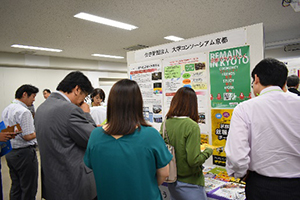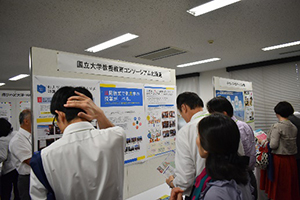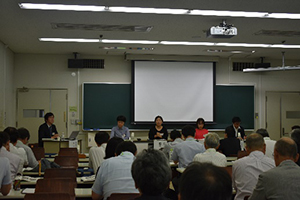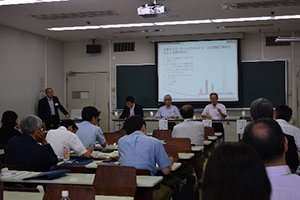Business Overview
In order to contribute to the development of higher education, we exchange information on the initiatives and research results of each university consortium.
Outline of the 16th National University Consortium Research Exchange Forum
- theme
- “Developing a University Together with a University Consortium”
- Purpose of the Tournament
- The challenges associated with the declining birthrate and aging population are serious enough to affect the foundation of Japan’s survival. In particular, the declining birthrate (the 18-year-old population, which peaked at 2.05 million in 1992 and stabilized at 1.2 million for the past 10 years, has been declining again since last year, 2018, and is expected to decrease to 880,000 in 2040. is a major problem for universities.
On the other hand, various reforms are being discussed in education policies related to the foundation of the country, from primary education to higher education, but it is not clear how permanent and effective they will be. In higher education, in particular, there is a strong demand for university entrance examination reform that emphasizes the connection between high school and university, as well as educational outcome goals and quality assurance, which should be the source of this.
Against this background, this forum will examine what the university consortium, which can be said to be a collection of knowledge in each region, should discuss and the role it should play. In addition to being a higher education institution responsible for cultivating local human resources, each member university will promote clarification and specialization of roles and functions, and will consider a wide range of issues, share knowledge and experience, and provide fruitful learning opportunities for the future. - schedule
- Saturday, August 31, 2019 10:00~19:30 (Poster session 12:00~15:00)
Sunday, September 1, 2019 9:30~11:30 - meeting place
- Kumamoto Gakuen University (2-5-1 Oe, Chuo-ku, Kumamoto City)
*On the first day, after the information exchange meeting, from Kumamoto Gakuen University to Kumamoto Station,
On the second day, after the breakout session, a free shuttle bus will be operated from Kumamoto Gakuen University to Kumamoto Station. If you wish to use the free shuttle bus, you must apply using the participation application form. - Co sponsored by
- National Association of University Consortiums
University Consortium Kumamoto - substance
- The 16th National University Consortium Research Exchange Forum Leaflet

- About Time Schedules and Locations
1> Saturday, August 31, 2019 Venue: Kumamoto Gakuen University time substance place 9:00~13:00 reception Entrance Hall of Building No. 14 10:00~11:30 Pre-Event: Workshop Room 1421, 2nd Floor, Building No. 14 12:00~12:30 General Meeting
ofthe National University Consortium Council
Conference Room 3, 4th Floor, Main Building 12:00~13:00 Poster Session Core Time Room 1412, 1st floor, Building No. 14,
Entrance hall13:00~13:15 Opening Remarks Bldg. 14, 1st floor
Morio Takahashi Memorial Hall13:15~14:15 Keynote Speech 14:15~15:00 Poster Session Core Time Room 1412, 1st floor, Building No. 14,
Entrance hall15:00~16:50 symposium Bldg. 14, 1st floor
Morio Takahashi Memorial Hall16:50~17:30 Cultural and Educational Administration Report 17:30~17:35 closing 18:00~19:30 Information Exchange Meeting
*After the information exchange meeting, a free shuttle bus to Kumamoto Station will be operated. If you wish to use it, you need to apply using the participation application form.Restaurant on the 1st floor of Building No. 7 -
2> Sunday, September 1, 2019 Venue: Kumamoto Gakuen University time substance place 9:00~9:30 reception Building No. 12, 1st floor 9:30~11:30 Subcommittee (1st ~ 5th Subcommittee)
*After the breakout session, a free shuttle bus to Kumamoto Station will be operated. If you wish to use it, you need to apply using the participation application form.Building No. 12, 4th Floor, Lecture Room -
1 details> Pre-event: 10:00~11:30 (Organized by the Steering Committee of the National University Consortium Council)
This event is intended for the management staff of the university consortium organization, and is intended as a place to share issues in management activities.
The National Council of University Consortiums will separately inform the consortium organizations and member organizations, and we are looking forward to receiving applications from the management staff.* The maximum number of participants is 35, so if there are applications that exceed the capacity, participants will be determined by lottery.
Keynote Speech: 13:15~14:15
theme University Consortium and the Potential of Campus Asia Keynote Speaker
Jiang Shangzhong Kumamoto Prefectural Theater Director First half of the symposium: 15:00~15:50
theme University development begins with university consortia Symposium Takahiro Kai
Kumamoto Economic Association Representative Secretary Mr. Taisuke Ono
Kumamoto Prefecture Deputy Governor Mr. Mineo Nakayama President of Sojo University Jiang Shangzhong Kumamoto Prefectural Theater Director coordinator Hideaki Hanto Representative Director, University Consortium Kumamoto
President of Kumamoto Prefectural UniversitySecond Half of Symposium: 16:05~16:50
QA session from the audience
Educational Administrative Report: 16:50~17:30
theme Trends in Higher Education Policy reporter Mr. Hiroki Hirano University Promotion Division, Higher Education Bureau, Ministry of Education, Culture, Sports, Science and Technology
Director, University Reform Promotion OfficeInformation exchange meeting: 18:00~19:30
-
2 details> Breakout sessions: 9:30~11:30
Subcommittee 1 (in charge: Education Network China)
theme FD/SD Workshop in University Consortium substance Unlike various training sessions held at each university, consortium training sessions can be expected to have different effects because participants from many universities gather. Based on the presentation on the current situation of the training at the University Consortium Kyoto and the Education Network in China, we will examine the effects of the training. In the panel discussion, clickers are used to proceed with the discussion while taking questionnaires from the floor. Through discussions, we will explore the significance of the existence of university consortia. reporter Mr. Yoshisada Masairu Deputy Secretary-General
,Educational Development Division, University Consortium Kyoto FD and SD projects in the University Consortium Kyoto Mr. Ichiro Mukaida Hiroshima International University Professor, Librarian, Chairperson of the Education Network China Training Committee
FD and SD Training in Education Network China Yuki Oki Professor
,Ritsumeikan University Educational Development Promotion Organization Present Status and Challenges of FD in Japan and Other Countries coordinator Tsutomu Mamoto
Professor, Hiroshima University, Vice President, Director of the Center for Integrated Education, Chair, Education Network China Inter-University-High School Collaboration Committee Subcommittee 2 (University Consortium Kyoto)
theme Support
for Students with Disabilities and University Consortium substance Although the
support for students with disabilities is premised on the efforts of each university, many universities have not yet established sufficient support systems or have not assigned personnel to support them. In response to this current situation, it will be very important for universities to collaborate and share knowledge and know-how in support. In this subcommittee, I would like to introduce examples of university consortiums working to support students with disabilities, and use this as an opportunity to think about their roles and prospects. reporter Emiko Tsuchihashi
Doshisha University Chief Coordinator of the Student Support Office for Students with Disabilities
Introduction of activities related to support for students with disabilities at the University Consortium Kyoto Shin Harada Associate Professor
,Okayama University University Education and Student Support Center Activities related to support for students with disabilities in the University Consortium Okayama Takafumi Fukunaga Kumamoto Prefectural College of Technology, Department of Information Systems Technology, Professor Introduction of activities related to support for students with disabilities in the University Consortium Kumamoto coordinator Jun Murata
Associate Professor, Student Support Center, Kyoto University (Chief Coordinator, Support Room for Students with Disabilities) Subcommittee 3 (University Consortium Kumamoto)
theme Crisis Management and Local Contributions of Universities: A Case Study of Earthquake Response- substance In April 2016, when the Kumamoto earthquake (M7.3) occurred, each university opened the university as an evacuation center, volunteered in the affected areas, provided mental care to residents in the affected areas, provided educational support for children in the affected areas, and provided reconstruction advice by faculty members in specialized fields. By introducing these initiatives and sharing information on the university’s crisis management system, we will provide an opportunity to learn how the university can contribute to disaster prevention and mitigation measures for natural disasters that are expected in the future. reporter Miwa Abe
Kumamoto University Kumamoto Revitalization Promotion Organization Associate Professor From volunteer activities to community activities after the earthquake Asuka Teruya Kumamoto Gakuen University Volunteer Coordinator Disaster shelter that accepted people with disabilities Sumiko Akiyoshi Associate Professor
,Department of Food and Nutrition, Junior College
Student participation in Masuki Town soup kitchen activities by NPO corporations
Ryosuke Ide
Tokai University Student Community Bonds and Challenges in Earthquakes: Minami-Aso Village and Kumamoto Earthquake coordinator Mr.
Michio Sawada
Kumamoto Prefectural University, Faculty of Management, Professor Subcommittee 4 (Non-profit organization University Consortium Osaka)
theme What are the activities of the University Consortium that lead to the growth and development of people, universities, and towns ?
substance University consortia across the country take advantage of their regional characteristics to carry out unique activities in collaboration with universities, local governments, and industry, and by collaborating with multiple organizations, activities that cannot be done individually are made possible, expanding the range and creating new activities. From another perspective, it can be said that the university consortium will be the core of creating a unique place for activities, so that the people who participate in it can connect, learn, and work together to grow themselves, which in turn will lead to the development of the university and the region. Here, we will think about what is expected of the “university consortium” that works to contribute to the growth and development of people, universities, and towns in the future. reporter Kunihiko Nakagawa
University Consortium Osaka Regional Collaboration Coordinator Activities of the University Consortium to Lead to Student Growth (tentative title) Kenichi Matsushita
Konan University Regional Cooperation Center Office Manager Business
development for the development of human resources in “Hometown Hyogo” at the Hyogo Industry-Government-Academia Collaboration Council Kuniaki Tanaka
Campus Consortium Hakodate Steering Committee The
Role of University Consortiums in University Education Reform: Considerations from the Member Organization Profile Sheet of the National Council of University Consortiums- coordinator Mr.
Takahiro Hisashi
Professor, Faculty of Sociology, Kindai University, Chairman of the Planning and Steering Committee of the University Consortium Osaka, Chairman of the Promotion Committee of the Regional Cooperation Subcommittee, Chairman of the Osaka Prefecture Regional Cooperation Platform Council Subcommittee 5 (Academic, Cultural and Industrial Network Tama)
theme How to develop human resources for regional revitalization substance What kind of human resources are needed by the business community to revitalize the region? What are human resources for regional revitalization? Japan’s total population has entered a phase of long-term decline, and the ideal of sustainable local communities in most regional cities and mountainous areas is being questioned. We will discuss in the “floor participation workshop format” based on the introduction of specific examples of human resource development plans necessary for regional revitalization in order to challenge the creation of new industrial forms and regional revitalization in the region. The above themes are important issues that will predict the future of the university consortium. Workshops will be held with the free participation of each consortium. In response to the “Keidanren version of the Regional Revitalization Human Resources” development plan (scheduled to be distributed on the same day), we will discuss university reform and university collaboration rooted in the local community based on current issues and future prospects. reporter Keiichiro Tomino Fukuchiyama Public University
Vice PresidentGoals and Challenges of Regional Public Human Resource Development Haruo Kimura
Director, Higher Education Research Office , Benesse Institute of Education
Current status and challenges of human resource development through industry-academia collaboration Mr. Sukehiro Hosono Academic, Cultural, and Industrial Network Tama Senior Managing Director,
Chuo University Professor EmeritusCommunity-wide human resource development coordinator Mr.
Sukehiro Hosono Academic, Cultural, and Industrial Network Tama
Executive Director, Professor Emeritus, Chuo University
Implementation Report
The 16th National University Consortium Research Exchange Forum was held at Kumamoto Gakuen University (Kumamoto City) for two days on Saturday, August 31 and Sunday, September 1, with the main theme of “Building a University Together with the University Consortium.”
At this forum, 297 people from higher education institutions and governments across the country participated in the forum in order to examine the content of the discussions and the roles that should be played by the University Consortium, which can be said to be a collection of knowledge in each region.
On the first day, a pre-event was held before the opening of the forum, where officials from the University Consortium Secretariat reviewed their activities and shared the challenges they feel on a daily basis in the operation.
The keynote speech was given by Mr. Sang-Jung Kang (Director of the Kumamoto Prefectural Theater) and a lecture entitled “The University Consortium and the Potential of Campus Asia.”
- Pre-event
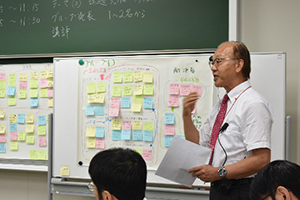
- Keynote speech
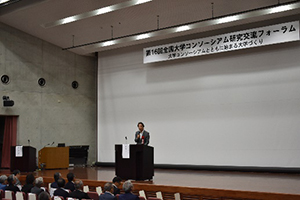
- ▽ Symposium
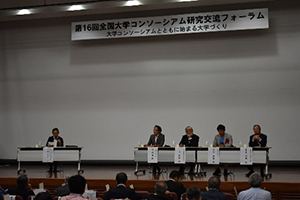
- ▽ Education Administration Report
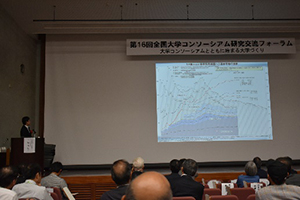
At the symposium that followed, Mr. Takahiro Kai (Representative Secretary of the Kumamoto Association of Corporate Executives), Mr. Taisuke Ono (Deputy Governor of Kumamoto Prefecture), and Mr. Mineo Nakayama (President of Sojo University) engaged in a lively discussion on “University Development Beginning with the University Consortium.”
In the report on education and education that followed, Mr. Hiroki Hirano, Director of the University Reform Promotion Office, University Promotion Division, Higher Education Bureau, Ministry of Education, Culture, Sports, Science and Technology, reported on trends in higher education policy.
In addition, in the poster session held in parallel with the symposium, many questions and comments were asked by the participants about the respective efforts of each consortium organization, and there was a scene where exhibitors and participants actively interacted.
▽Poster session (20 exhibitors)
On the second day, five subcommittees were held on various themes, including “FD and SD Training in University Consortiums,” “Support for Students with Disabilities and the University Consortium,” “Crisis Management and Universities’ Community Contribution: A Case Study of Earthquake Disaster Response,” “What are the activities of the University Consortium that lead to the growth and development of people, universities, and communities?” and “How to develop human resources for regional revitalization.” Practical case reports and exchanges of opinions with participants were held.
▽ Breakout sessions (5 subcommittees in total)
The next 17th forum is scheduled to be held in Osaka in September 2020. Details will be announced on the website of the University Consortium Kyoto as soon as they are decided.
Thank you for your participation.
Inquiries
Secretariat of the National Association of University Consortiums (University Consortium Kyoto)
TEL 075-353-9100 FAX 075-353-9101
〒600-8216 Shimogyo-ku, Kyoto-shi, Nishitoin-dori, Shiokoji, Shimo-ku, Kyoto, Campus Plaza Kyoto
* Reception hours: Tuesday ~ Saturday 9:00 ~ 17:00 (excluding year-end and New Year holidays)














